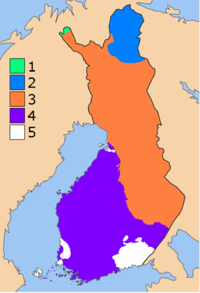Lapland Granulite Belt

Map showing the large-scale geological units of Finland. The Lapland Granulite Belt and the Inari complex (2) are shown in blue. The Older Karelian Domain (3) is orange coloured.
The Lapland Granulite Belt is an elongate and arcuate zone of granulite rock in the Cap of the North spanning areas within Norway, Finland and Murmansk Oblast in Russia. At most the belt is 80 km broad. The main rocks of the belt are migmatized greywacke and argillites. Studies of detrital zircon show that the sedimentary protolith of the metamorphic rocks of the belt could not be older than 2900–1940 million years.[1] The belt has norite and enderbite intrusions of calc-alkaline chemistry.[2]
It is believed that the belt formed by the closure of an ancient Lapland-Kola Ocean and the continental collision of two continents of Archean age.[1]
References
- 1 2 Lundqvist, Jan; Lundqvist, Thomas; Lindström, Maurits; Calner, Mikael; Sivhed, Ulf (2011). "Svekokarelska Provinsen". Sveriges Geologi: Från urtid till nutid (in Swedish) (3rd ed.). Spain: Studentlitteratur. pp. 60–61. ISBN 978-91-44-05847-4.
- ↑ Lahtinen, Raimo; Korja, Annakaisa; Nironen, Mikko; Heikkinen, Pekka (2009). "Palaeoproterozoic accretionary processes in Fennoscandia". In Cawood, P.A.; Kröner, A. Earth Accretionary Systems in Space and Time. 318. Geological Society, London, Special Publications. p. 237–256.
This article is issued from Wikipedia - version of the 10/9/2015. The text is available under the Creative Commons Attribution/Share Alike but additional terms may apply for the media files.